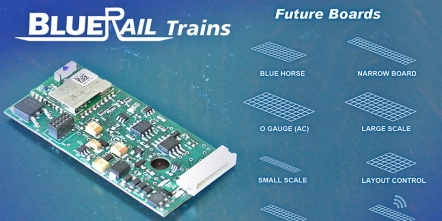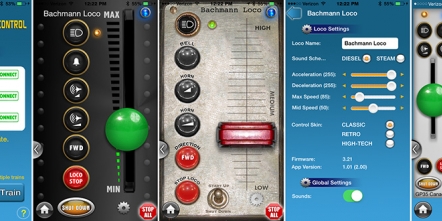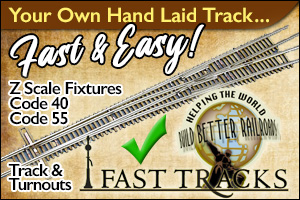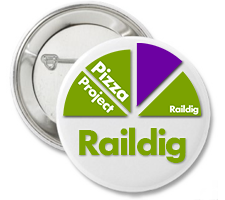David Rees | BlueRail Trains
I recently read about BlueRail Trains and their new control system for trains, but not the sort of control system I’m used to seeing. Not DCC, but one that can be run right alongside DCC and doesn’t need a lot of hardware in the middle. A system that looks incredibly elegant to me that requires little more than a control board in a locomotive, power to the rails and a downloadable app for iOS or Android.
I contacted David Rees of BlueRail Trains to learn more about their system and David was good enough to take the time for the following interview with us here at Raildig.
 Can you give us a brief overview of your BlueRail model train control system? Just to confirm, BlueRail is not the same as DCC?
Can you give us a brief overview of your BlueRail model train control system? Just to confirm, BlueRail is not the same as DCC?
BlueRail is the idea of putting a Bluetooth Smart chip in your loco, and running it directly from your controller (which happens to be a smartphone or tablet) without the need for additional equipment.
DCC generally involves using a hardware DCC controller to encode and send signals through the track to be interpreted by a DCC decoder in the loco.
With BlueRail, you don’t need equipment, but aside from the connection method, you can have the same control over a train as you could with a DCC system. Bluetooth Smart can equally be used to run a decoder, so we have plans to visit DCC control in the near future.
But the good news is, you can run a Bluetooth Smart train (or plugin board) on ANY POWERED TRACK SYSTEM, so it doesn’t matter whether you have DC, DCC, DCS, or TMCC – you can run a Bluetooth Smart train alongside your other trains.
How does a BlueRail board connect to a locomotive?
BlueRail involves having a Bluetooth Smart (also known as Bluetooth LE, BLE and Bluetooth 4) chip in your locomotive.
Bluetooth Smart should not be confused with old school Bluetooth (as used in cars or with Bluetooth speakers). Bluetooth Smart is a brand new aspect of Bluetooth (as used to connect to an Apple Watch). Bluetooth Smart allows for unlimited simultaneous connects at hundreds of feet.
As long as you have a BlueRail Bluetooth module in your loco, you can connect and operate it directly from any Bluetooth Smart device.
Why is the Bluetooth LE protocol well suited to wireless train control?
I can give you 6 great reasons Bluetooth LE is well suited for train control:
- Unlimited simultaneous connections – Bluetooth Smart has no defined limit on the number of simultaneous connections (trains) you can make. Perhaps we will find a limit someday, but for now it is safe to say you can use Bluetooth Smart to simultaneously run as many trains as you desire.
- Great range – I have run BlueRail boards outdoors from 170 ft. Indoors I can operate the train from three walls a way. You have probably never heard anyone complain their Apple Watch or BLE medical pacemaker was having connectivity issues or being interfered with by other Apple Watch. Bluetooth Smart provides solid connections with little interference (even through brass). In my testing, the range is not negatively affected by a crowded hall full of wireless activity.
- Bi-directional communication – One of the challenging issues in DCC is the lack of bi-directional communication. That is, DCC commands you send to your train are on a one-way trip. Your loco cannot speak back to you and give you feedback. This is very valuable for lots of reasons, including speed-matching and load/position management. With Bluetooth Smart, every loco is constantly in communication with the control app, and so, effectively in communication with each other, and can interact more effectively.
- Wireless firmware updates – This is one of the most valuable features of BlueRail. One of the biggest concerns in a hobby like model railroading is equipment that becomes obsolete. BlueRail involves NO EQUIPMENT – only a Bluetooth Smart module running BlueRail firmware and any Bluetooth Smart device (phone/tablet) running the free app. Because the firmware in the train can be updated wirelessly from your phone at any time, we can continue to add new features and expand the protocol knowing these features can be easily added to every train out there.
- Direct connection to a micro-computer (smart device) – This may not seem obvious at first, but connecting your train to a high-end computer (like a smartphone or tablet) opens up a new set of options on ways to enjoy your train. If you are interested in Operating Session simulations, recording and saving scripted train routines, or easily adding new content to your train, then you might enjoy the applications BlueRail is creating to allow you to experience your train in new ways. BlueRail has 20 years of experience creating software and user interfaces. We are very excited about the opportunity to give train control a great interface, simplify use without losing functionality, and creating new user experiences.
- Dead Rail support – Because our system doesn’t rely on track signals, BlueRail is an excellent choice for Dead Rail (battery powered trains). All BlueRail plugin boards have connection points for optional battery power.
Is BlueRail a DCC replacement or competitor?
No, I wouldn’t call BlueRail a replacement or a competitor of DCC. Bluetooth Smart is just a direct way to control your train that comes with some nice advantages, works nicely on DCC systems (and offers the potential for DCC interoperability). One of my goals is to get to the stage where our software control app does not care whether your train is DCC or not, and to provide solutions for both options.
BlueRail boards can plug into any DCC-Ready train and can run on a DCC layout, so in that way they are already compatible.
Will BlueRail interact directly with DCC in any way in the future?
Yes, I’m sure it will. For many reasons it made the most sense to develop train control that doesn’t require DCC, but we are eager to also create solutions that control DCC. We are simultaneously developing the Bachmann E-Z App system (which will be compatible with all BlueRail products). Bachmann is very interested in DCC interoperability, so I would expect DCC interoperability to be a focus soon for us.
Will BlueRail allow for control that DCC currently enjoys such as speed matching locomotives, adjustable control for speed steps, Back EMF, momentum control?
Yes, we support speed-steps, back-EMF and momentum control. And BlueRail’s bi-directional connection will allow all trains to communicate and cooperate, making issues like speed-matching less of a concern in consisting.
As a follow-up, slow speed performance is usually more highly coveted by seasoned model railroaders than by beginners in the hobby. How does the BlueRail system stack up against a high quality DCC chip in this area?
Once the Bluetooth signals have reached the loco, the differences between the systems end; we deliver the same pulses to operate the motor and accessories as a DCC decoder does. We drive the motors using an ultra-high frequency pulse-width modulation (just as in DCC) and have dedicated many hours to tuning the slow-speed performance. Just as in DCC, we have adjustable variables that allow users to further tune their individual locos. So the technology for achieving slow-speed operation is identical between the two systems. And with our firmware updates we can make continuous improvements.
Do you see BlueRail as a tool just to get younger people involved in the hobby, or will it have appeal to more seasoned model railroaders?
Well, I think connecting trains directly to smart devices is definitely a tool to bring younger people into the hobby. Bachmann E-Z app trains are proving very popular with kids. They can purchase a loco, download the free app and start running trains. While Bachmann sells E-Z App trains, BlueRail is focusing its attention on developing Bluetooth Smart plugin boards, software and circuitry that target the serious model railroaders. We think of ourselves as a technical-creative R&D team and try to focus on hardware advances and app development.
I’ve seen you have several additional BlueRail boards planned for the future. Do you have any sort of schedule for release at this time?
We have partnered with Bachmann to simultaneously developing the E-Z App system. It is convenient to develop products in tandem with Bachmann’s interests. BlueRail started with HO and will move onto larger scales. And we are excited about DCC, layout control, and hopefully smaller scales. The first Bachmann E-Z App trains are now available in stores. The first BlueRail plugin boards will be available January 2016.
Because we develop with Bachmann, I cannot give specific timetables beyond tackling HO this holiday, but we are eager to tackle larger scales, DCC, and layout control in 2016. We are also aware of smaller modules coming out Q1 2016 that bring hope to smaller scales.
If a user already has an investment in DCC, is there a compelling reason for them to look into BlueRail?
If you are heavily invested in a Digitraxx, NCE, Lionel or DCS system, you may or may not be the first one running out and buying an E-Z App train this Thanksgiving. But there is very little investment in getting a Bluetooth Smart train or plugin board – all you need is a Bluetooth loco (or a plugin board) and it will run perfectly on your layout with your other trains. So you can find out what it’s about without changing a thing. And as more features (DCC and other interactivity) come along, you can enjoy those too. Hopefully the added perks of smartphone control will eventually become appealing enough that even hardcore users will be won over.
Apple’s iOS has about 15% of the smartphone market against 75% of the market belonging to Android. The tablet race seems a bit tighter, but it does seem Android leads in terms of overall usage. How does the Android system fit in to your plans?
BlueRail has been in software development for twenty years. We have been developing iOS and Android applications as long as those platforms have existed. The Bachmann release of E-Z App trains this fall will suddenly create a large user base. We thought it was wisest to release with one platform initially (iOS) rather than supporting the release of a new train control system on two platforms simultaneously. We see porting Android as only a couple months of development, and will release an Android app after we have survived the initial product release.
The statistics we are seeing (when you take BLE into account) are 44% iOS and 52% Android.
DCC onboard sound has become viable in basically all model train scales. Does the BlueRail system make use of sound?
BlueRail will ultimately support in-loco sound. In order to get the first bluetooth trains out for the holidays, it did not make sense for BlueRail to develop the in-loco sound system for this fall’s release. But all BlueRail plugin boards contain an expansion port designed to accommodate future sound module add-ons. For this holiday season (2015) all train sounds will come from the smart device or any Bluetooth or AirPlay speaker on your layout. Many people like the Bluetooth speaker option. You can look forward to future in-loco sounds sometime soon.
Looking at some of the online user forums, it seems folks are not 100% clear on exactly how BlueRail fits into the world of model railroading going forward. What would you want these folks to know about BlueRail?
I think when people think about a “train control system” they are used to thinking about popular train control “systems” that involve buying interacting components. The problem with hardware circuit components is they often eventually become obsolete. BlueRail is simply the “idea” of losing all the hardware and having an updateable software controller, and handling all details in updateable firmware in a Bluetooth module.
I don’t think this means DCC manufacturers are in trouble. I’d like to think Bluetooth will simply become a great communication protocol that has applications across the hobby. And I’m excited to be working everyday to help make this happen.
Direct control of your trains is a natural concept after you’ve tried it. I know there is a gut reaction when some people read about the Bachmann E-Z App trains to assume that this is for kids (and I am excited about bringing new interest to the hobby). I believe as existing hobbyists start to see all the performance, simplicity, and added capabilities Bluetooth Smart offers this misconception will wane.
Personally I am very excited about developing applications that will expand the experience beyond just train control. I’d like to think as those app add-ons become available users will see the added potential value.
Article Links
BlueRail Trains
http://www.bluerailtrains.comBlueRail Trains Facebook Page
https://www.facebook.com/BlueRailTrainsBlueRail Trains YouTube Channel
BlueRail Trains YouTube VideosBluetooth Smart (Bluetooth LE, BLE and Bluetooth 4)
Bluetooth Smart Wikipedia PageBachmann E-Z App
Bachmann E-Z App PageDCC, Digital Command Control
DCC Wikipedia Page
Category: Raildig Guest

















